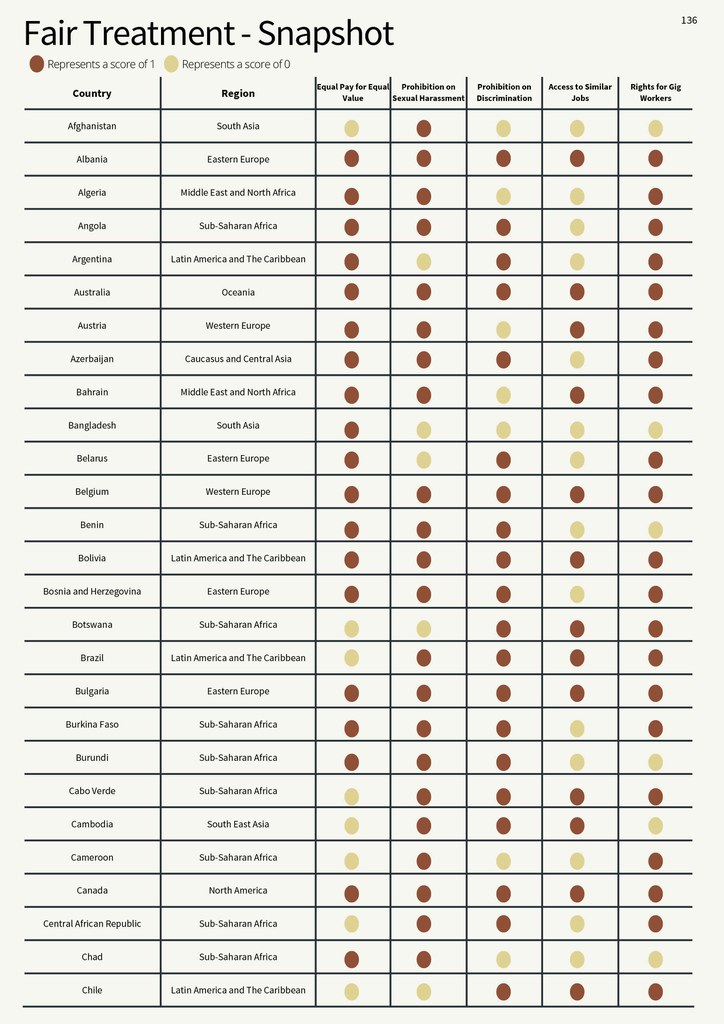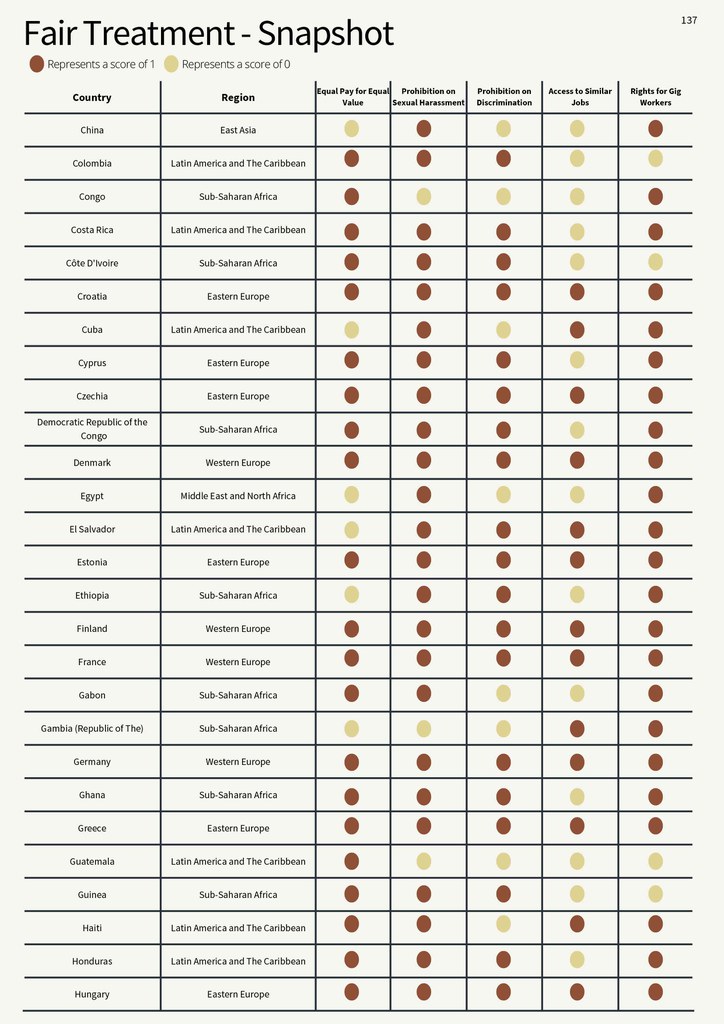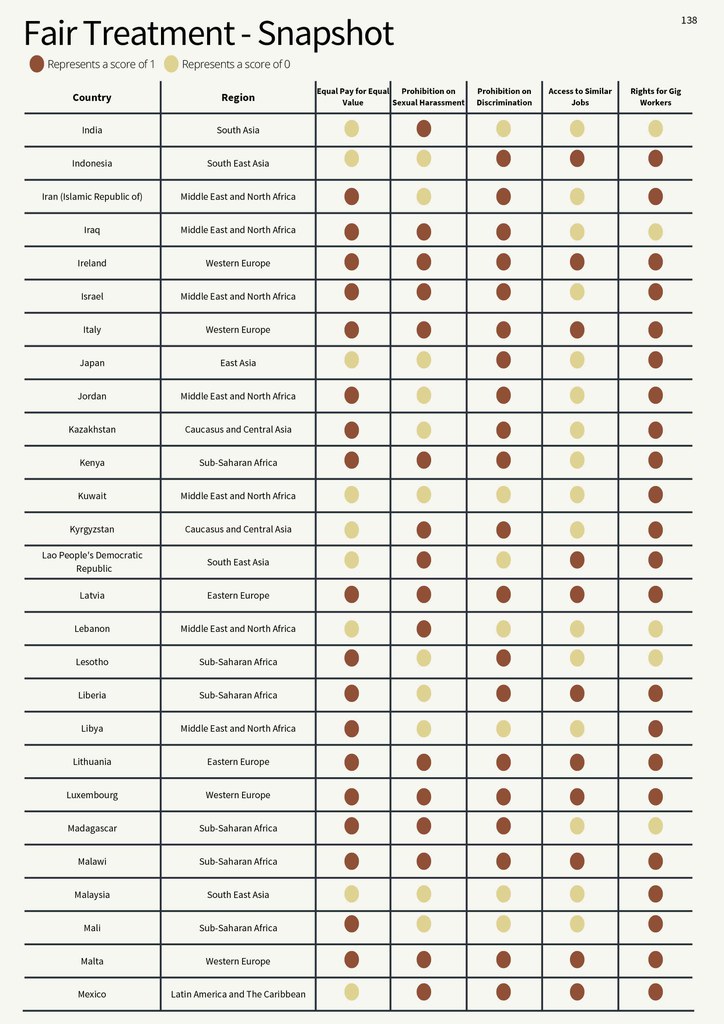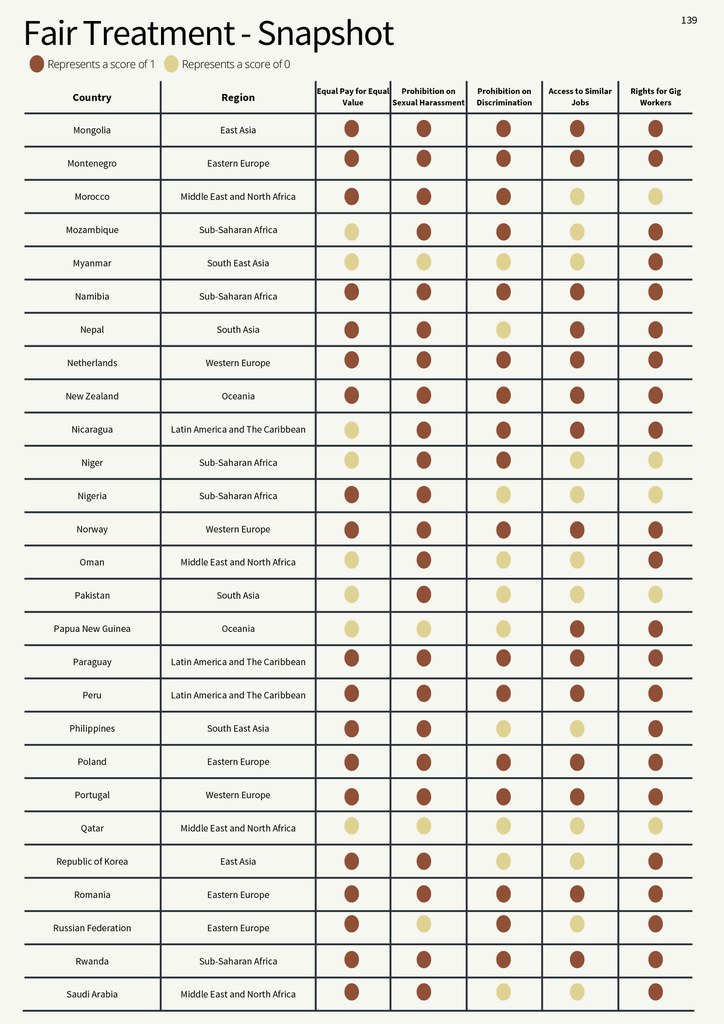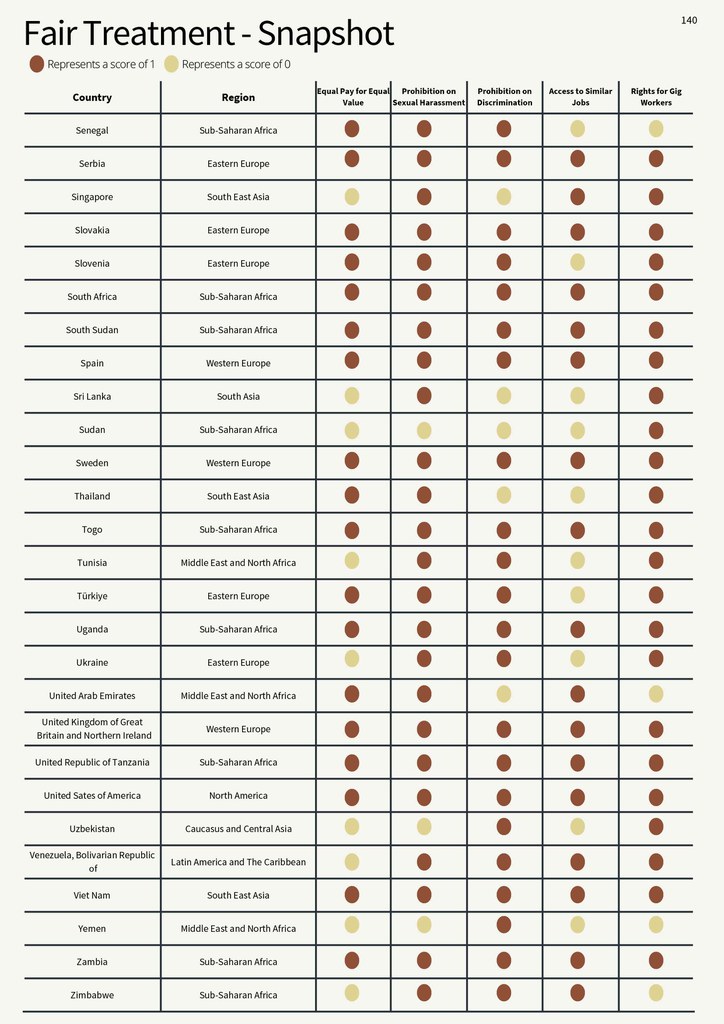Fair Treatment
The Fair Treatment indicator measures legislation causing wage gap, discrimination in employment matters, sexual harassment at work, employment segregation and unequal access to basic labour protection for gig workers. Equal remuneration for all workers, referring to the rates of remuneration without discrimination based on gender and any other discriminatory grounds is the fundamental requirement for promoting non-discrimination at the workplace.
8.1 Equal Remuneration
Does the law require equal remuneration for men and women workers for work of equal value?
International Regulatory Standard
Article 2 of the Equal Remuneration Convention, 1951 (No. 100) stipulates that the principle of equal remuneration for men and women workers for work of equal value should be promoted and ensured for all workers by means appropriate to the methods in operation for determining rates of remuneration. This principle may be applied through national laws or regulations, legally established or recognised machinery for wage determination, collective agreements between employers and workers, or a combination of these various means.
Methodology
Whether the law requires equal remuneration for work of equal value:
1: The legislation mandates equal remuneration for male and female workers for work of equal value without discrimination on the grounds of sex.
0: The law limits the principle of equal remuneration to the same work, similar work, equal work or work of a similar nature.

8.2 Sexual Harassment in Employment
Does the law prohibit sexual harassment in employment?
International Regulatory Standard
Article 7 of the Violence and Harassment Convention, 2019 (No. 190) states that without prejudice to and consistent with Article 1 (definitions of violence and harassment as well as gender-based violence and harassment), each Member shall adopt laws and regulations to define and prohibit violence and harassment in the world of work, including gender-based violence and harassment. Article 10 of the Convention suggests that members may impose sanctions, where appropriate, in cases of violence and harassment in the world of work.
Methodology
Whether law prohibits sexual harassment at work:
1: The legislation protects against workplace sexual harassment.
0: There is no such legislation or if it addresses harassment in general or has a general prohibition on harassment only without any criminal penalties (either fines or imprisonment) or civil remedies (monetary compensation for victims and recovery of damages).

8.3 Discrimination in Employment
Does the law prohibit discrimination in employment matters?
International Regulatory Standard
Article 2 of the Discrimination (Employment and Occupation) Convention, 1958 (No. 111) states that equality of opportunity and treatment in respect of employment and occupation, with the purpose of eliminating any discrimination, should be promoted.
Article 8 of the Maternity Protection Convention, 2000 (No. 183) prohibits employers from terminating the employment of a woman during her pregnancy or absence on leave or during a period following her return to work to be prescribed by national laws or regulations, except on grounds unrelated to the pregnancy or birth of the child and its consequences or nursing.
Methodology
Whether the law prohibits discrimination in employment:
1: The law prohibits employers from discrimination or mandates equal treatment of all workers in an employment matter. A score of 1 is assigned only if a country has prohibited discrimination on at least seven of the above ten grounds.
0: the law does not prohibit such discrimination or only prohibits such in one aspect of employment, such as pay or dismissal. The prohibited grounds for discrimination are “race, colour, sex, religion, political opinion, national extraction or social origin, age, disability and trade union membership".
27% of the countries, representing more than 52% of the global labour force, do not prohibit discrimination in employment on at least 7 of the 10 grounds.
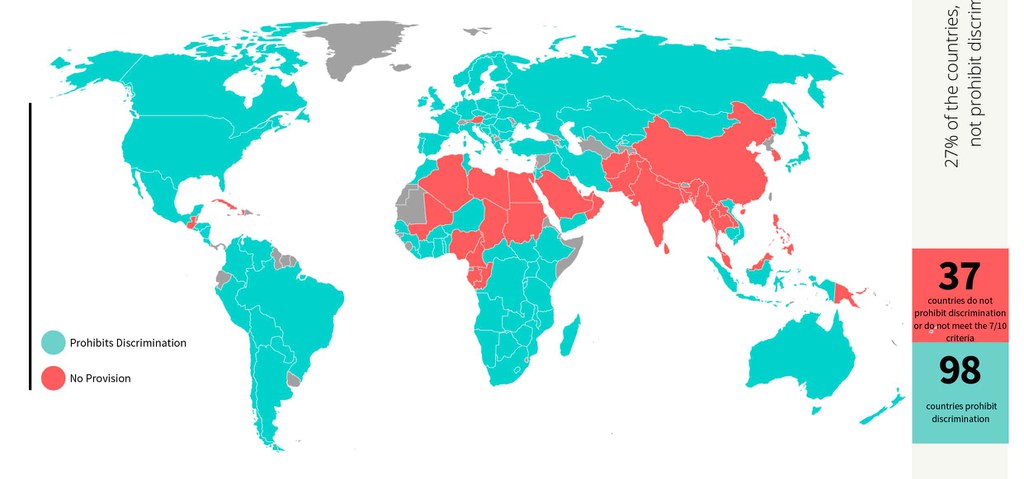
8.4 Access to Same Jobs as Men
Does the law allow women to do the same job as men?
International Regulatory Standard
The Discrimination (Employment and Occupation) Convention, 1958 (No. 111) requires each ratifying Member to declare and pursue a national policy designed to promote, by methods appropriate to national conditions and practice, equality of opportunity and treatment in respect of employment and occupation, to eliminate any discrimination in respect thereof.
Methodology
Whether the law allows women to do the same jobs as men:
1: The legislation does not restrict non-pregnant and non-nursing women from working in the same jobs as men.
0: The law prohibits or restricts women from working in jobs deemed hazardous, arduous, morally inappropriate and during night hours.
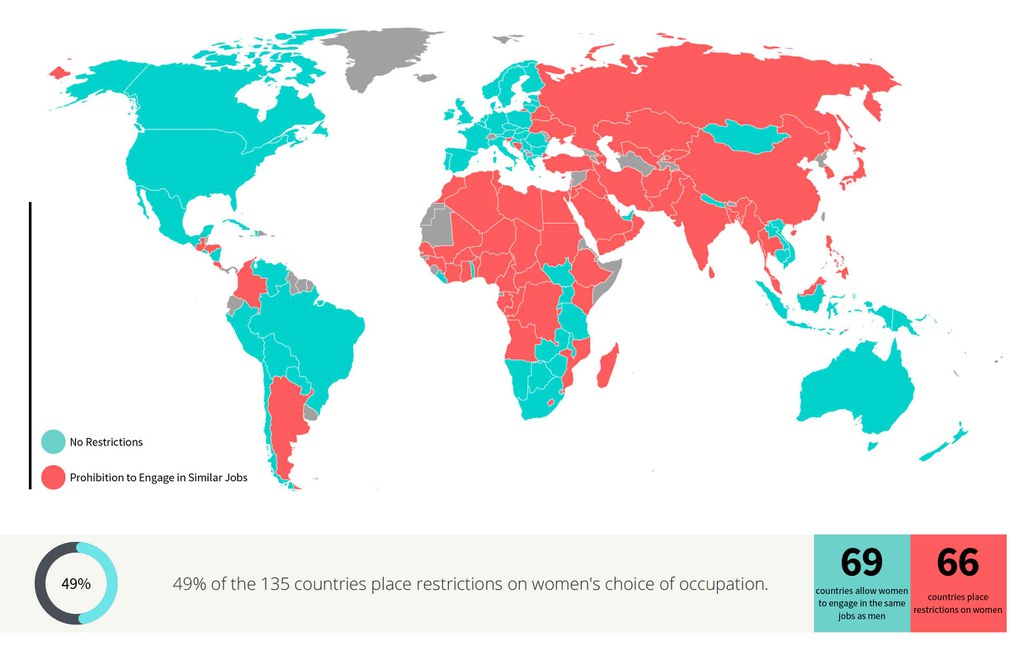
8.5 Basic Social Protection - Gig Economy
Does the law guarantee basic labour protection to the gig economy workers?
International Regulatory Standard
The Global Commission on the Future of Work 2019 recommended the development of an “international governance system for digital labour platforms”, requiring platforms (and clients) to respect certain minimum rights and protections. The Maritime Labour Convention 2006 (MLC, 2006) can be used as an example.
Similarly, provisions of the Tripartite Declaration of Principles concerning Multinational Enterprises and Social Policy (MNE Declaration) 2017, can be used as guiding principles.
Methodology
Whether the law guarantees basic labour protection to the gig economy worker:*
1: Considering the new phenomenon of the gig economy, a score of 1 is currently assigned to all such countries which provide at least the basic social protection** (old age pension, survivors’ benefits and invalidity benefits) to self-employed workers.
0: The basic social protection is not afforded to self- employed workers or where access to these benefits is linked to citizenship.
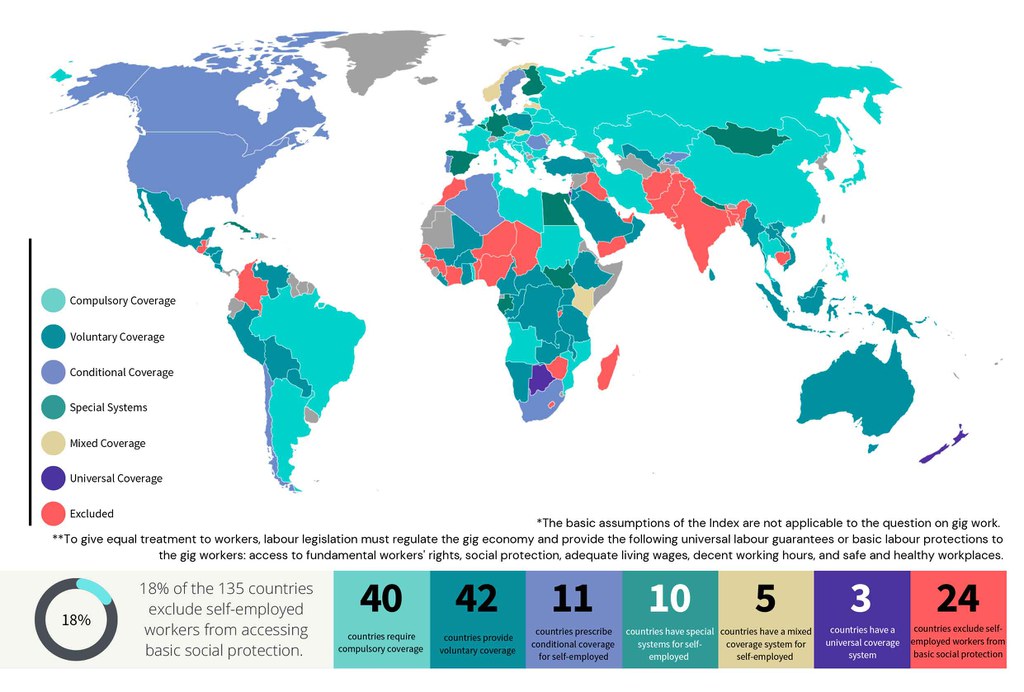
Fair Treatment - Snapshot
